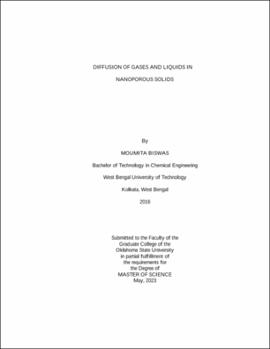| dc.contributor.advisor | White, Jeffery L. | |
| dc.contributor.author | Biswas, Moumita | |
| dc.date.accessioned | 2023-08-25T20:06:38Z | |
| dc.date.available | 2023-08-25T20:06:38Z | |
| dc.date.issued | 2023-05 | |
| dc.identifier.uri | https://hdl.handle.net/11244/338972 | |
| dc.description.abstract | The diffusion of gases and liquids under nanoconfinement is of fundamental importance for understanding various processes like catalysis, enhanced oil recovery, and CO₂ sequestration. The present contribution narrates how diffusion NMR was used as a quantitative method to study the transport of probe molecules in nanoporous solids when the fluids are subjected to variable pressure. Nanoporous glass (NPG) and zeolites have been considered for investigation in this work. NPG was selected as a model system to study confinement effects, diffusion, and partitioning of liquid water and liquid cyclohexane. Self-diffusion coefficients of methane were measured in several commercially-important zeolites as a function of pressure, with a specific focus on experimental reproducibility and minimization of error in the calculated diffusivities. To identify differences in transport properties on modification of zeolites with different silica to alumina ratios, methods such as ammonium-hexa-fluoro-silicate (AHFS) treatment, phosphoric acid treatment, steaming, and, lanthanum ion exchange were employed. Variable pressure of nitrogen gas and methane were applied to the NPG and zeolites samples, respectively and their self-diffusion coefficients were measured. One of the primary outcomes of the research was the development of a complete method for introducing gases into nanoporous solids, specifically zeolite catalysts, at variable pressure that yields highly reproducible diffusion coefficients. With these improvements, the NMR diffusometry experiments have revealed that CH4 at elevated pressure is a sensitive probe of both chemical and topological perturbations to zeolite catalyst structures, and thereby applicable to a variety of systems in which sorbents, reagents, and surfactants are sequestered in nanoporous hosts. | |
| dc.format | application/pdf | |
| dc.language | en_US | |
| dc.rights | Copyright is held by the author who has granted the Oklahoma State University Library the non-exclusive right to share this material in its institutional repository. Contact Digital Library Services at lib-dls@okstate.edu or 405-744-9161 for the permission policy on the use, reproduction or distribution of this material. | |
| dc.title | Diffusion of gases and liquids in nanoporous solids | |
| dc.contributor.committeeMember | Aichele, Clint P. | |
| dc.contributor.committeeMember | Kim, Seokjhin | |
| dc.contributor.committeeMember | Weaver, Jimmie | |
| osu.filename | Biswas_okstate_0664M_18034.pdf | |
| osu.accesstype | Open Access | |
| dc.type.genre | Thesis | |
| dc.type.material | Text | |
| dc.subject.keywords | diffusion | |
| dc.subject.keywords | nanoconfinement | |
| dc.subject.keywords | nanoporous glass | |
| dc.subject.keywords | nuclear magnetic resonance | |
| dc.subject.keywords | zeolite | |
| thesis.degree.discipline | Chemical Engineering | |
| thesis.degree.grantor | Oklahoma State University | |
